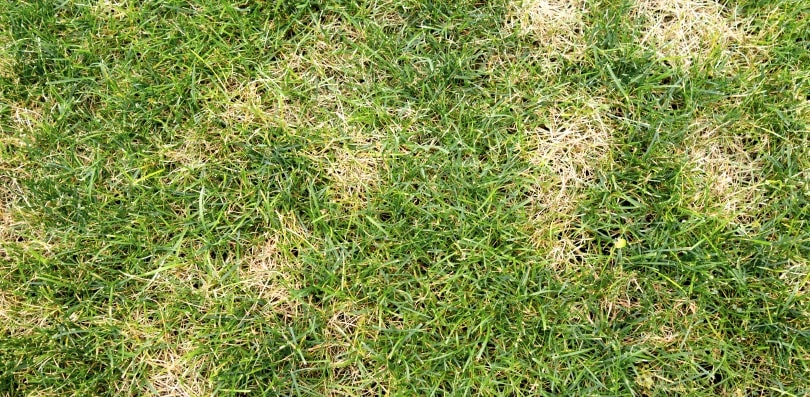How To Get Rid Of Brown Spots In Grass

Homeowners across America are painfully familiar with Brown Patch Disease. Caused by a single strain of fungus called Rhizoctonia, brown patch affects many common turfgrass varieties and can occur anywhere that experiences hot, humid weather during summer months. While the fungus typically does not kill grasses, it can render your lawn unsightly and can easily get out of control if left untreated. Our expert lawn care technicians will take you through everything you need to know about the brown spots in your lawn, including:
- What Does Brown Patch Look Like?
- What Causes Brown Patch?
- How Can I Prevent Brown Patch?
- How to Get Rid of Brown Spots in Your Grass
What Does Brown Patch Look like?
Brown Patch is characterized by its eponymous patches of brown and dead-looking grass on your lawn. These patches typically manifest in brown or discolored rings in affected grass, ranging from several inches to several feet across. Infected grass normally becomes thinner than unaffected grass and takes on a wispy and unhealthy appearance. In cases where the fungus kills infected grasses, the afflicted area will appear sunken relative to the surrounding lawn. Once you see the brown spots take root in your yard, it will quickly spread until it has consumed every blade of green grass in your lawn.
What Causes Brown Patches in Grass?
When the weather becomes hot and humid, the inactive fungus can quickly infect areas of your lawn, leading to its signature brown patches. Knowing what causes brown spots in your lawn can help you prevent it. You know what they say: an ounce of prevention is worth a pound of cure. Here are some factors that cause brown patches:
Excess Water and Nitrogen:
Unbalanced levels of nitrogen and moisture can lead to favorable conditions for Rhizoctonia to cause brown patch disease in your lawn. Rhizoctonia thrives in wet, nitrogen-rich environments and when you combine this with poor quality soil, excessive water can lead to a variety of fungi buildup on your lawn. Additionally, low-quality soils require high levels of fertilizer which can lead to a buildup of nitrogen and your grass will ultimately suffer.
Animals:
Animal urine can cause high nitrogen levels in the soil even when fertilizers aren’t in use. This leads to a nitrogen buildup in targeted areas of your lawn and gives brown patch an opening, even in an otherwise healthy lawn.
Fertilizers:
Some fertilizers can actually harm your grass because they contain too much nitrogen. It can be difficult to know which type of fertilizer to use and when to use it, so we recommend talking to a professional about what would be best for your lawn.
Shade:
Brown spots can thrive in areas of your lawn that don’t get a lot of sunlight.
Mowing:
Mowing your lawn, while necessary, can be a stressful experience for your grass. Stress will cause your grass’ roots to function less efficiently, depriving them of nutrients, and weakening their resistance to fungus and disease. Cutting your grass too short can interfere with its ability to photosynthesize and cause a similar outcome.
Watering:
Brown spots can occur where there is standing water on your lawn.
Leaves:
Believe it or not, leaves promote fungus growth and can cause brown spots to take root.
How Can I Prevent Brown Patch?
You know what they say: an ounce of prevention is worth a pound of cure. Here are some factors that cause brown patches, and what to do to solve the problem:
- Try to have your pets go to the bathroom in different areas of your lawn, so one section isn’t getting more urine than others. If you can, water the area where your pet went to the bathroom to clear the nitrogen from the grass.
- You can prune overhanging trees and shrubs to allow more light and air to enter these areas of your yard.
- Set your mower to one of the two highest settings. You can mow less frequently when the weather is hot and humid to let your grass accumulate a healthy amount of nutrients.
- A good rule of thumb when watering your lawn is one inch of water per week. If we’re experiencing really hot and dry conditions, then two inches a week will help your lawn stay healthy. Be wary of areas where the water isn’t soaking into the soil, and try to drain these locations to prevent brown patches.
- Don’t wait a while to rake your leaves when they fall—rake your lawn periodically to take care of the leaves.
- Professional lawn care is the best way to consistently keep brown spots at bay and the only way to reverse its effects. There are, however, methods that you can use to protect your lawn and give it a fighting chance.
How to Get Rid of Brown Spots in Your Grass
When brown patch settles in, professional help is the fastest and most reliable way to stop it from spreading. At Southern Spray, our lawn care professionals create and maintain healthy lawns all across Tennessee. We’ll help stop the spread of brown patch disease and give you a green and healthy yard again. Our technicians service Nashville, Memphis, and the surrounding Tennessee and Mississippi areas.





